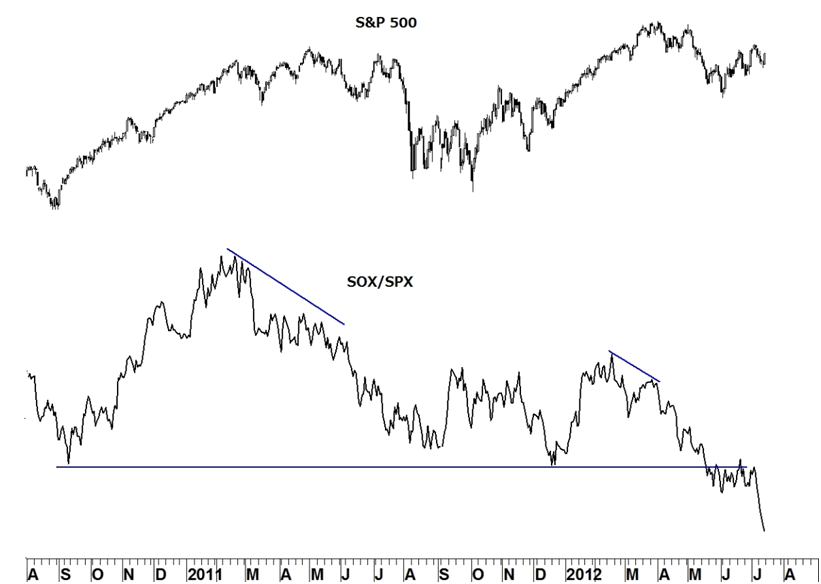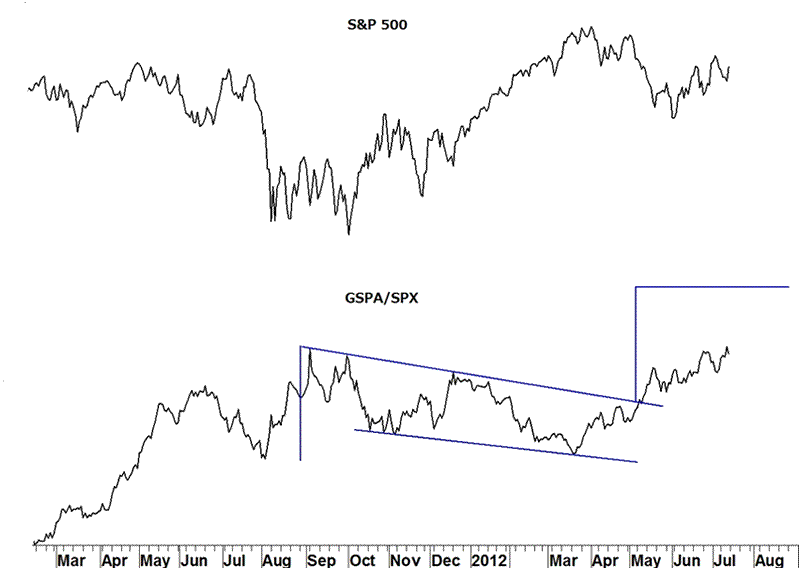Stock Market Relative Strength Today
Stock-Markets / Stock Markets 2012 Jul 17, 2012 - 06:41 AM GMTBy: Submissions
 Ed Carlson writes: Certain sectors of the market are known as being market leaders; financials, technology, small caps, etc. Technicians have long-known that without participation by those “market leaders”, rallies in the broader averages won’t be able to sustain themselves. Others, often called defensive sectors, are said to “outperform” in a down market; utilities, healthcare, consumer staples, etc. The term “outperform” should not be equated with “profitable”. It simply means these sectors will do better than others in a particular environment (bull or bear market). Knowing which groups are outperforming gives us an important clue as to which direction the broader market is headed. So how can we tell which sectors are outperforming? Ratio Charts.
Ed Carlson writes: Certain sectors of the market are known as being market leaders; financials, technology, small caps, etc. Technicians have long-known that without participation by those “market leaders”, rallies in the broader averages won’t be able to sustain themselves. Others, often called defensive sectors, are said to “outperform” in a down market; utilities, healthcare, consumer staples, etc. The term “outperform” should not be equated with “profitable”. It simply means these sectors will do better than others in a particular environment (bull or bear market). Knowing which groups are outperforming gives us an important clue as to which direction the broader market is headed. So how can we tell which sectors are outperforming? Ratio Charts.
Ratio charts are created by simply dividing the data of one sector by a broader average such as the S&P 500. Place the charting data of the sector-of-interest in the numerator and the S&P 500 in the denominator. When the resulting line chart is rising, it means the sector being examined is outperforming the broad market. When the line chart is falling, it means that sector is underperforming. So what are Ratio charts telling us now?
If we believe current market action in the broad averages is bullish we should expect our ‘market leader’ ratio charts to be advancing. Looking at the ratio chart between semiconductors and SPX we find (even with last Friday’s rally) the line chart continues to make new lows; bearish. Ratio charts also lend themselves to the standard techniques of technical analysis. Here we see that the SOX/SPX ratio has broken the long-term support line. Long before that, however, it showed a negative divergence earlier this year foreshadowing the April – June decline just as it did in early 2011. This sort of market action for an important leader like semiconductors makes it difficult to be bullish on the broad equity market.

Taking a look at the S&P Healthcare index (a defensive sector) versus SPX we can see how this sector underperformed (trended down) during the October – April advance in the S&P 500 just as we would expect it to during a market rally. We can also see how it turned upward at the April top in the S&P 500 and broke out from a descending trend channel. It has even been outperforming during the post-June advance! A simple measured move from the breakout implies that outperformance in healthcare still has a big move ahead.

Similar situations are seen in other ratio charts. These charts seem to be saying that any rally from last Friday will be short-lived. Until we see leaders like technology start to outperform, it’s probably a good bet that the July downtrend is still alive and well.
Ed Carlson, author of George Lindsay and the Art of Technical Analysis, is an independent trader, consultant, and Chartered Market Technician (CMT) based in Seattle. Carlson is an instructor at the New York Institute of Finance, hosts the MTA Podcast Series, and manages the website Seattle Technical Advisors.com, where he publishes daily and weekly commentary. He spent twenty years as a stockbroker and holds an M.B.A. from Wichita State University.
© 2012 Copyright Ed Carlson - All Rights Reserved Disclaimer: The above is a matter of opinion provided for general information purposes only and is not intended as investment advice. Information and analysis above are derived from sources and utilising methods believed to be reliable, but we cannot accept responsibility for any losses you may incur as a result of this analysis. Individuals should consult with their personal financial advisors.
© 2005-2022 http://www.MarketOracle.co.uk - The Market Oracle is a FREE Daily Financial Markets Analysis & Forecasting online publication.



